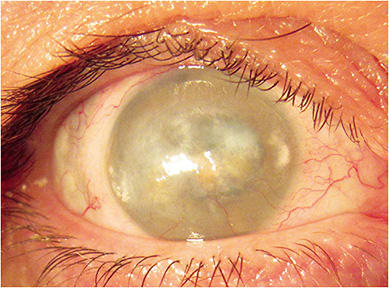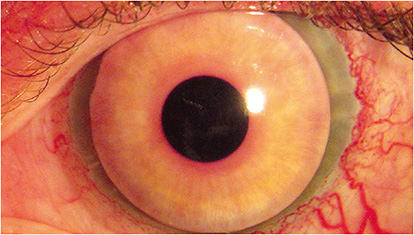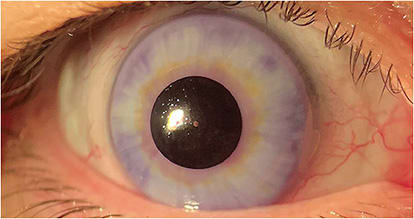This offering can be a rewarding service to add to your practice
Incorporating specialty contact lenses into your practice provides a needed service, but it also is rewarding work that expands your practice scope. Soft prosthetic contact lens fitting is an important specialty lens service that largely has an unmet need. Here’s an example:
A 55-year-old female patient reported for a prosthetic contact lens evaluation for cosmetic improvement. She had severe corneal scarring of her right eye (Figure 1) post-retinal detachment. Photographs of both eyes were taken, in addition to measurements of her left eye that included; iris diameter (Figure 2) and photopic pupil size.


How would you proceed?
PATIENT CANDIDATES
Prosthetic soft lenses provide either a cosmetic or functional role for candidates who have severe corneal scarring or leukocoria, oftentimes to the extent that they have little to no vision and are self-conscious about their appearance. For these patients, soft prosthetic lenses can be life changing by concealing their scarred eye.
Functionally, prosthetic soft lenses can help in two ways:
First, they are able to occlude an eye that isn’t contributing visually but has enough vision to cause distractions or binocular diplopia.
Second, they can act as an artificial iris for patients who have aniridia or traumatic mydriasis. These patients often have disabling glare, photophobia and increased higher-order aberrations that can be significantly improved with a prosthetic lens that allows for a normalized pupil during use.
LENS OPTIONS
Two available soft prosthetic lens options include computer-generated and hand-painted lenses.
Technological advancements have resulted in outstanding and realistic computer-generated designs that look natural and allow for reasonable matching of iris appearance with the other eye. Most patients can be successful with this prosthetic option.
Hand-painted lenses, which are more expensive, are an alternative when color matching is difficult or if the artificial iris needs offsetting on the lens to cosmetically correct for strabismus.
For both prosthetic options, a black backing is necessary to best hide the corneal scar or block light in the case of a mydriatic pupil. If the patient has correctable vision, the pupil can be left clear with optical correction. Frequently replaced cosmetic colored contact lenses available to correct ametropia don’t have this black backing and, as a result, typically are not successful for prosthetic candidates.
Of note: Soft prosthetic lenses are almost never covered by medical insurance, so make sure to discuss out-of-pocket expenses. Vision plans may apply, depending on the diagnosis, or workers compensation might approve the costs if the patient’s issue was a work-related injury.
COSMETIC CONTACT LENS MANUFACTURERS
PROSTHETIC
- ABB Optical Group
- Advanced Vision Technologies
- Adventure in Colors
- Bausch + Lomb Specialty Vision Products
- Color Max
- Contour Contact Lenses
- CR Studios
- Crystal Reflections
- Custom Color Contacts
- Impressions Contact Lenses
- Orion Vision G
- Marietta Vision
- Medcorp International
- Softchrome
- Specialty Tint
- SwissLens
- United Contact Lens
- Venus Color Contact Lenses
NON-PROSTHETIC COSMETIC ENHANCEMENT
- Acuvue
- Alcon
- CooperVision
THE PATIENT
A diagnostic soft lens was ordered that had a base curve of 8.2 mm and a diameter of 14.5 mm to ensure proper fit. The lens was trialed with acceptable centration and movement. A color match of her left eye was determined using a color guide supplied by the manufacturer. A finalized prosthetic soft lens was ordered with a black backing and closed pupil, using the previous measurements of her left eye, diagnostic lens parameters, and color match (Figure 3). The dispensed lens concealed her corneal scarring and was an acceptable match with her left eye. She was prescribed a lens solution for nightly cleaning and disinfection. Planned lens replacement is yearly.

Adding prosthetic soft lens fitting to your contact lens practice allows you to significantly improve the lives of patients who will benefit cosmetically or functionally from these lenses. OM




